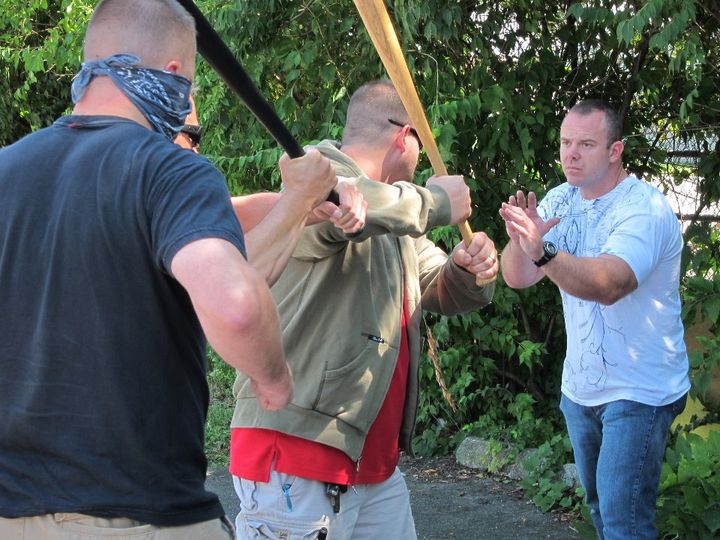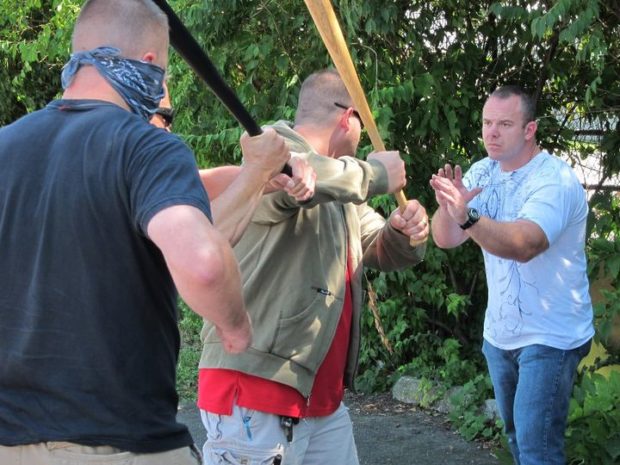Written by Greg Ellifritz
Depending on the source of the research you read, you’ll find that about 40% of violent criminal attacks will involve you fighting more than one attacker. Fighting one person is bad enough. Fighting a group is exponentially worse.
I’m seeing lots of recent news articles where groups of teens attack individuals and couples. The teens often beat the victims into unconsciousness. Take a look at these news articles that have been posted in the last couple weeks.
Columbus police looking for teen girls involved in Schiller Park attack
Girl Seen on Video Being Brutally Attacked by Group
Group attacks bouncer, security at Pacific Beach restaurant
Brutal beating where man is stomped repeatedly in Jersey City is caught on video
Video shows police employee viciously beaten in Baltimore street
DC Tourist Savagely Beaten, Stomped, Spit on by Gang of Youths at Hilton Hotel
All of these events involved groups of three to eight criminals attacking a single person or a couple. These group attacks seem to be increasing in frequency. What can we do about them? Here are a few suggestions…
1) The best way to win the fight is to avoid it. Know where groups of youths congregate in your city. Do your best to avoid those areas, especially after dark.
Another important concept is the idea that “you can’t make an appointment for an emergency.” You don’t know when bad things will happen. You may not have time to access all of your tools. You will probably fight with whatever gear you have on your person when the attack goes down. Wearing flip flops and being unarmed isn’t really a recipe for success. If you need a tool to win your fight, you better have it ready at all times.
If you are violently attacked by a group, your goal should be to escape as quickly as possible. Run away. Use obstacles such as cars or other objects to prevent your attackers from reaching you. If you have a longer range weapon, deploy it to keep the attackers as far away from you as possible. Pepper spray would be a good first step to deal with multiple unarmed attackers. I don’t leave home without mine. If you are traveling through areas with amassing groups of youths, have it in your hand and use it at the very first sign of a conflict.
2) Multiple attackers are more dangerous to you. That seems obvious, but many people seem to forget the amount of damage that can be done. While you are fighting one bad guy, the others can take your back and really put a hurting on you. Whenever multiple attackers are involved, you need to escalate your levels of force. Three people beating you with fists is most likely a lethal force situation. You would be justified in using a deadly weapon to repel the attack.
Don’t forget that once multiple people are involved, it’s a fight not a wrestling match. You shouldn’t be trying to detain someone for the police. You should not be grappling with one of your attackers. Your efforts should be focused on doing serious damage your attackers. Consider strikes, kicks,and impact weapons if you don’t have any pepper spray. If your initial efforts to escape or utilize defensive sprays don’t immediately work, it’s likely time to escalate to your firearm..
3) Whenever possible, try to “stack” your attackers. Move to the outside of the group, so that your attackers are temporarily lined up in a manner that allows you to fight one person at a time. Such movement isn’t always possible, but will lead to higher rates of success if they can be implemented. Your goal should be to create as much chaos in the fight as possible. Any time you make your attackers get in each others way you create opportunities to cause severe damage or escape.

Author moving to the outside of a group of attackers to “stack them up”. Fighting one person at a time is better than fighting all three at once
4) If you end up grappling with one of your attackers, use him as a shield to keep between you and the other attackers. Take your attacker’s back and manipulate the attacker’s body between you and the remaining attackers. Try to avoid letting any attacker get behind you.
5) Chokes are important. Learn how to choke someone out. Find a Judo or JuJitsu instructor and pay them for a private lesson. You’ll be glad you did. It’s one of the fastest ways to win a fight. If you can choke your “shield” out, it will make life much easier on you
The book Choke ’em Out: 65 Chokes to End Any Fight Fast is a good reference if you can’t find an instructor in your area. Unfortunately, its publisher went out of business and it is quite expensive now. The second best reference you can get (for a reasonable price) is The Grappler’s Book of Strangles and Chokes.
6) Don’t go to the ground. Groundfighting is the worst option in most multiple attacker situations. To win a fight against more than one attacker, you will need mobility, visibility and access to tools. All of those are limited when you are on the ground. These group attacks almost always end up with the attackers stomping the grounded victim. There’s no easier way for an unarmed attacker to do more damage to you than when he is stomping your head into the pavement. Stay on your feet if possible.
7) If you can’t escape, stack your attackers, or manipulate one to be a shield, you must attack. There are differing schools of thought as to who you should attack first (the biggest, the smallest, the leader, the closest) but I don’t really think it matters. Attack one of them with the goal of doing as much damage as possible. In my experience, that tends to shock the others and may often cause them to flee. There really isn’t any honor among thieves. Even if the others don’t run away, causing serious damage to one will likely open up a “hole” to allow you to escape.
Practice hard, keep your awareness up and try to avoid this stuff. If you can’t prevent the attack, remember the advice above and do what you need to do in order to make it home.
If you would like to read more articles like this, please sign up for my email updates.
Some of the above links (from Amazon.com) are affiliate links. As an Amazon associate I earn a small percentage of the sale price from qualifying purchases. It does not cost you any money.
If you would like to further support my work, head over to my Patreon page.


